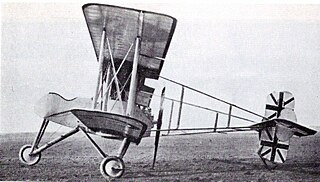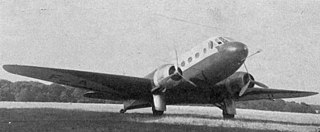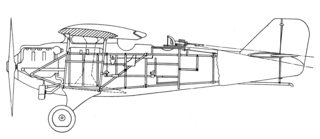
The Breguet XIV or Breguet 14 is a French biplane bomber and reconnaissance aircraft of World War I. It was built in very large numbers and production continued for many years after the end of the war.

The Aero A.42 was a Czechoslovakian bomber aircraft of 1929 that was only ever produced in prototype form. For its day, it was an advanced design, with a sleek monoplane configuration. However, the Czechoslovak Air Force was not satisfied with it for a number of reasons. In particular, the aircraft's take-off and landing runs were felt to be excessively long, and crew complained about the cramped cabin. The air force suggested a set of modifications to Aero, including replacing the wooden wing with a metal one, but Aero discontinued development.
The Bréguet 690 and its derivatives were a series of light twin-engine ground-attack aircraft that were used by the French Air Force in World War II. The aircraft was intended to be easy to maintain, forgiving to fly, and capable of 480 km/h (300 mph) at 4,000 m (13,000 ft). The type's sturdy construction was frequently demonstrated and the armament was effective. French rearmament began two years later than that in Britain and none of these aircraft were available in sufficient numbers to make a difference in 1940.

The Bréguet 521 Bizerte was a long-range military reconnaissance flying boat built by the French aviation company Breguet.

The Dewoitine D.27 was a parasol monoplane fighter aircraft designed by Émile Dewoitine in 1928.

The Bréguet Br.1001 Taon was a 1950s French prototype single-seat jet strike fighter aircraft built by Bréguet.

The Bréguet Bre.4, also known variously as the Type IV and BUM, was a French biplane bomber of World War I. A fighter version of it was also produced as the BUC and BLC; some of these saw service with the British Royal Navy, which called them 'the Bréguet de Chasse.

The Potez-CAMS 141 was a French long range reconnaissance flying boat of the late 1930s. Intended to equip the French Navy, only a single prototype was completed before the German invasion of France stopped production. That prototype did, however serve operationally from bases in French North Africa until scrapped in 1943.

The Bréguet 730 was a French flying boat of the 1930s. Built to meet the requirements of the French Navy, it was ordered into production but no aircraft were delivered before France surrendered to Germany in June 1940. Four remaining incomplete airframes were completed after the end of World War II, serving with the French Navy until 1954.

The Sikorsky S-16, or RBVZ S-XVI, was a Russian equi-span single-bay two-seat biplane designed by Igor Sikorsky in 1914-15. Conceived in response to demand for an escort fighter for the Ilya Muromets bombers, it was noteworthy in that it was one of the first aircraft to possess synchronisation gear for its 7.7 mm machine gun. The first S-XVI was completed on 6 February 1915 with an 80 hp engine instead of the intended 100 hp because of supply problems. On 17 December 1915, the Russian government placed an order for 18 aircraft, these being delivered in early 1916.

The Morane-Saulnier AN or MoS.31 C.2 was a French two seat fighter prototype of the 1910s that resulted in the development of several other unsuccessful Morane-Saulnier prototypes.
The Bréguet 482 was a French four-engined heavy bomber aircraft designed just prior to the outbreak of the Second World War with two prototypes nearing completion when Germany invaded France in 1940, one of which was flown after the end of the war as an experimental platform.

The Bréguet 460 Vultur was a French bomber of the 1930s. Few of these twin-engined monoplanes and its variant, the Breguet 462 Bréguet , were built. At least one Breguet 460 was sold to the Spanish Republican Air Force during the Spanish Civil War.
The Dewoitine D.770 was a prototype French twin-engined attack aircraft of the late 1930s. It was intended as a replacement for the Breguet 693 but testing was incomplete by the time that of the Franco-German Armistice, and no production followed.

The Bréguet 670, Bréguet 670T or Bréguet-Wibault 670 was a French twin engine, all metal eighteen seat airliner with a retractable undercarriage flown in 1935. Only one was built.
The Caudron C.580 was a French advanced trainer aircraft intended to prepare pilots for the new low wing monoplane fighters of the mid-1930s. It did not go into production and only two were built.

The Bréguet 25 or XXV was a French two seat fighter from 1925. It was heavily armed, carrying seven machine guns.

The Bréguet XI was a prototype French biplane bomber of the First World War.
The Lioré et Olivier LeO 9 was a French monoplane fighter built in 1923.
The Borel C.A.P. 2, later SGCIM C.A.P. 2, was a prototype, all-metal framed, high-altitude sesquiplane fighter and reconnaissance aircraft with a supercharged engine, built in France around 1920. It was displayed, uncovered, at the 1922 Paris Salon.
This page is based on this
Wikipedia article Text is available under the
CC BY-SA 4.0 license; additional terms may apply.
Images, videos and audio are available under their respective licenses.














